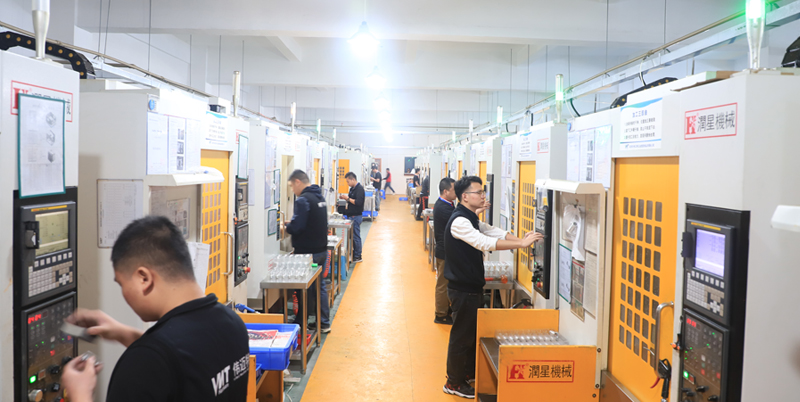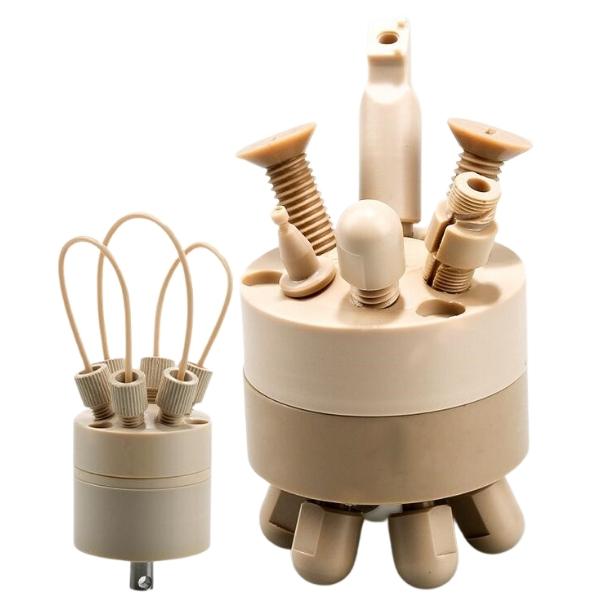15 years one-stop China custom CNC machining parts factory

Hey there I’m VMT Sam!
With 25 years of CNC machining experience we are committed to helping clients overcome 10000 complex part-processing challenges all to contribute to a better life through intelligent manufacturing. Contact us now
 231 |
Published by VMT at Sep 23 2023
231 |
Published by VMT at Sep 23 2023
We have more than 100 precision plastic CNC machining equipment, have cooperated with 9000+ customers, and 1000+ customers have obtained the best medical PEEK CNC machining parts. Contact us now to learn more about our expertise and request a quote online for your desired CNC machining project.

What is Medical Grade Peek CNC Machining?
Medical-grade PEEK CNC machining refers to the precision manufacturing process of medical components and devices using Polyether Ether Ketone (PEEK) as the primary material. PEEK is a high-performance thermoplastic polymer known for its exceptional properties, including biocompatibility, resistance to harsh chemicals, and high-temperature stability.

The key characteristics of medical-grade PEEK CNC machining include:
1. Biocompatibility: PEEK is well-suited for medical applications as it is biocompatible, meaning it is well-tolerated by the human body and does not cause adverse reactions.
2. Precision Machining: CNC (Computer Numerical Control) machining is used to fabricate intricate and precise medical components from PEEK material. This method ensures that the final products meet the exact specifications and quality standards required for medical use.
3. Chemical Resistance: PEEK is highly resistant to chemicals, making it suitable for applications where contact with various substances is expected.
4. Sterilizability: Medical-grade PEEK can withstand various sterilization methods, such as autoclaving, gamma radiation, and ethylene oxide gas sterilization, without compromising its properties.
5. Radiolucency: PEEK is radiolucent, meaning it does not interfere with X-ray and other imaging technologies, making it ideal for medical devices used in diagnostics.
6. Mechanical Properties: PEEK has excellent mechanical properties, including high strength and stiffness, which makes it suitable for a variety of medical applications such as implants and surgical tools.
Common applications of medical-grade PEEK CNC machining include orthopedic implants, dental components, surgical instruments, and various medical device components.
The stringent quality control measures and adherence to medical industry regulations ensure that medical-grade PEEK CNC machining delivers high-quality and safe products for medical and healthcare applications.
Medical Devices PEEK CNC Machining Disadvantages
1. Cost: PEEK can be more expensive than some alternative materials, which can impact the cost of medical devices.
2. Radiopacity: While radiolucency is an advantage, in some cases, medical devices may need to be visible in X-rays or CT scans. In such situations, additional markers or coatings may be required.
3. Wear Resistance: PEEK's wear resistance is good but may not be as high as certain metals or ceramics. In high-wear applications, additional considerations may be necessary.
4. Surface Modifications: Achieving specific surface properties, such as enhanced osseointegration for implants, may require additional treatments or coatings.
5. Regulatory Requirements: Meeting regulatory requirements for medical-grade PEEK materials can involve strict quality control and testing, which can add complexity to manufacturing processes.
Despite these disadvantages, PEEK remains a popular choice for various medical devices due to its unique combination of properties. The selection of materials for a particular medical application should consider the specific requirements, performance criteria, and regulatory standards to ensure patient safety and device effectiveness.
Medical Devices PEEK CNC Machining: Proven Applications
Medical-grade PEEK (Polyetheretherketone)machining material is a highly sought-after material in the healthcare industry due to its exceptional properties and biocompatibility. It finds a wide range of applications in the production of critical components for medical devices. Here are some common medical-grade PEEK CNC machining applications and the components they involve:
1. Orthopedic Implants: PEEK is extensively used in orthopedic implants such as spinal cages, interbody fusion devices, and joint replacement components. Its high strength, biocompatibility, and radiolucency make it ideal for load-bearing applications in orthopedics.
2. Dental Devices: Dental implants, brackets, and orthodontic appliances benefit from PEEK's biocompatibility and radiolucency. These components require precision machining to ensure proper fit and function.
3. Cardiovascular Devices: PEEK is employed in various cardiovascular devices, including pacemaker headers, leads, and insulating components. Its dimensional stability and resistance to bodily fluids make it a reliable choice in this field.
4. Surgical Instruments: Many surgical instruments.
5. Medical Tubing and Catheters: PEEK's chemical resistance and flexibility make it suitable for medical tubing and catheters. These components are crucial for fluid management and patient care.
6. Diagnostic Equipment: Components of diagnostic equipment, including housing and structural elements, are often manufactured from PEEK. Its high precision machining capabilities contribute to the accuracy of medical imaging devices.
7. Drug delivery systems: PEEK is used in drug delivery systems to ensure the compatibility of components with various drugs and biocompatibility with drugs.
8. Endoscopic Devices: Endoscopic components, such as camera housings and insertion tubes, benefit from PEEK's combination of light weight, durability, and resistance to sterilization procedures.
9. Neurological Implants: PEEK is used in neurological implants, including brain electrodes and deep brain stimulation (DBS) components, where biocompatibility and stability are paramount.
10. Ophthalmic Devices: In ophthalmology, PEEK is employed in components like intraocular lens (IOL) haptics, thanks to its inertness and resistance to environmental factors.
11. Prosthetic Limbs: PEEK components play a role in prosthetic limb design, ensuring lightweight, strong, and corrosion-resistant parts.
These applications demonstrate the versatility and reliability of medical-grade PEEK in addressing a wide range of healthcare needs. CNC machining is instrumental in creating precise and custom components for medical devices, ensuring they meet stringent quality and regulatory standards while improving patient care and outcomes.
Why is PEEK plastic more expensive than other materials?
PEEK (Polyether Ether Ketone) machining materials are typically more expensive than many other plastics and materials due to several factors:
1.Raw Material Costs: The primary factor driving up the cost of PEEK plastic machining is the expense of the raw materials. PEEK is derived from petroleum-based feedstocks, and its production involves complex chemical processes. Limited availability of raw materials, coupled with strict quality control requirements for medical-grade PEEK, contributes to its cost.
2.Manufacturing Processes: The production of PEEK plastic machining materials involves high-temperature polymerization and extrusion processes that require specialized equipment and controlled environments. These processes necessitate energy, expertise, and quality control, further increasing manufacturing costs.
3.Outstanding Performance: PEEK is highly regarded for its exceptional performance, including high-temperature resistance, chemical resistance, electrical insulating properties, and biocompatibility. These attributes make it suitable for demanding applications but also lead to higher costs because achieving these qualities requires advanced manufacturing techniques and high-quality raw materials.
4.Regulatory Compliance: In industries such as medical and aerospace where PEEK is widely used, there are strict regulatory requirements. Producing PEEK materials that conform to these standards requires extensive testing and quality assurance procedures, which add to production costs.
5.Customization: PEEK plastic machining materials are often used in applications that demand precision and customization, such as medical implants or aerospace components. Manufacturing high-precision and tailored PEEK CNC parts requires specialized CNC machining or 3D printing equipment, increasing overall costs.
6.Low-Volume Production: PEEK production typically doesn't match the scale of other plastics like polyethylene or polypropylene. Lower production volumes can result in higher unit production costs.
7.Research and Development: Ongoing research and development efforts are conducted to improve PEEK materials and develop new grades with enhanced properties. These R&D expenses impact the overall cost of PEEK products.
8.Quality Assurance: PEEK plastic machining materials must adhere to stringent quality control standards, especially in industries where safety and reliability are critical, such as healthcare and aerospace. Ensuring consistent quality adds to the costs of the manufacturing process.
Despite the higher cost, PEEK plastic machining materials remain a preferred choice in applications that require its unique combination of properties. It can withstand high temperatures, aggressive chemicals, and mechanical stresses while also offering biocompatibility, making it a valuable material in industries where performance and reliability are non-negotiable.
Customized PEEK CNC Machining Parts VMT
With 13 years of PEEK CNC machining experience, we can complete prototype CNC machining in 1 day and maintain strict tolerances to complete delivery. If you are looking for a CNC machining manufacturer to get a quote for your PEEK project (or another plastic we process), please email us today: inquiry@vimetal.com.cn or call +86 15099911516.
Ready To Start Your Next Project?
Get Instant Quote

Request a Free Quote
Send us a message if you have any questions or request a quote. We will get back to you ASAP!